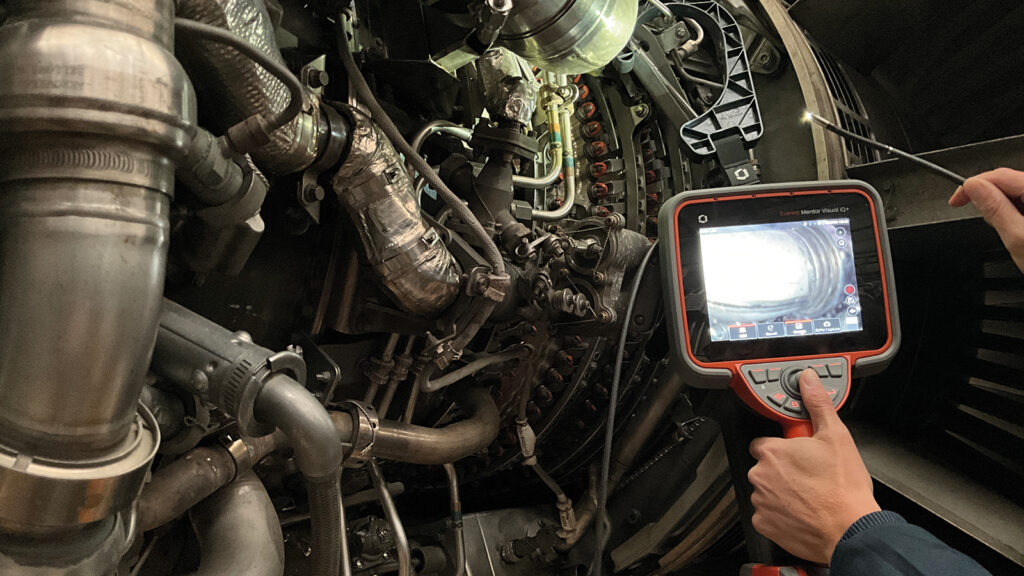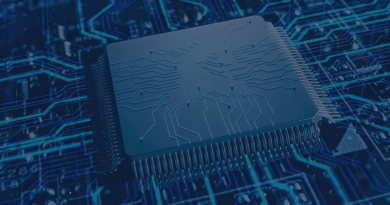The ABCs of NDT for Aircraft
Seeing the unseeable: NDT checks keep planes in the air safely
Quality and verification are requisite to determine and validate an aircraft’s airworthiness, and keep personnel and passengers safe. Aircraft undergo numerous scheduled maintenance routines, as well as unscheduled inspections following unexpected events such as lightning strikes, bird strikes or other incidents.
Non-destructive testing (NDT) plays a vital role throughout an aircraft’s lifecycle—from raw material selection and manufacturing to assembly and in-service maintenance. NDT methods help detect defects or imperfections that could compromise structural integrity, preventing failures and extending the aircraft’s operational life.
NDT extends service life of parts by catching issues early, preventing unnecessary replacements and maintains compliance with strict aviation regulations and standards from FAA and EASA.
Aircraft safety is non-negotiable, even a tiny crack or flaw could lead to catastrophic failure. “NDT is vital to aviation because it identifies hidden flaws without damaging aircraft parts,” explains Peter Pelayo, Product Manager and an NDT Level III for Met-L-Chek, Cleveland. “Modern airplanes can have more than 6,000 moving parts, and NDT ensures that even the smallest components are safe and reliable. This practice underpins what many call the ‘impossible infrastructure’ of flight, where huge, complex machines can remain airborne. NDT enables a proactive maintenance approach, ensuring aircraft remain safe and airworthy throughout their service life.”
“All parts of an aircraft can be verified with NDT methods from wings to fuselage, engine but also windows, wheels,” says Angélique Raude, Global NDT Application & Market Development Director in the Test & Measurement Division at Evident, France. “For each assembly, material, defect type a suitable inspection technique is being deployed limiting the need for repairs, change of part, etc.”
Larry Culbertson, CEO/RL3 at NDT Solutions (NDTS), Signal Hill, California, stresses that NDT is not just a maintenance task, it is an essential life-or-death safeguard that must be completed, sometimes even daily. He cites the following common aircraft structures and parts tested with NDT:
Fuselage (main structure): Check for cracks, corrosion, fatigue near doors, windows and joints.
Wings: Monitor for stress cracks, especially near attachment points and fuel tanks.
Landing gear: Inspect for cracks, corrosion, and stress fractures— takes heavy impact loads.
Engine components: Blades and turbine parts are inspected for micro-cracks and overheating damage.
Control surfaces (ailerons, elevators, rudders): Inspect for cracks, corrosion and bonding failures.
Composite structures: Test for delamination, impact damage that isn’t visible on the surface.
Blades and propellers: inspected for cracks and corrosion, especially at the blade roots.
NDT Testing Methods for Aircraft
Hürth, Germany-based Waygate Technologies, a Baker Hughes business, offers a comprehensive suite of NDT equipment, software and services. Ben Linke, CEO at Waygate Technologies explains the three primary NDT methods to ensure the integrity of aircraft components are remote visual inspection (RVI), ultrasonic testing (UT) and industrial radiography and computed tomography (CT). “These inspection technologies are applied across the entire lifecycle of aircraft components, from verifying the quality of initial materials to assessing the condition of finished parts and supporting in-field maintenance and repair. The choice of which technology to use depends on the specific inspection requirements.”
Culbertson explains that, “When it comes to modern aircraft design, there is a damage tolerance philosophy that assumes that some cracks might form during service, but that the important thing is detecting them early enough. This philosophy depends heavily on regular, reliable NDT. No single NDT method finds every defect. That’s why multiple techniques are often required.” He cites the following aircraft NDT methods, applications and rationale: Ultrasonic Testing (UT): Used for thick structures like wings, fuselage skins and composite panels. It’s great for detecting internal cracks, delaminations and corrosion. Ultrasonic resonance can be used for bonded structures.
Eddy Current Testing (ECT): Used for surface/near-surface cracks in fuselage, landing gear and fastener holes. It’s fast and highly sensitive to tiny cracks, especially in conductive metals like aluminum.
Mag Particle Testing (MT): Used for landing gear and engine shafts (ferromagnetic parts). It’s good at detecting surface and shallow subsurface cracks however only works on ferromagnetic materials.
Penetrant Testing (PT): Used for surface crack detection in non-porous materials (engine parts, landing gear). It’s good at finding surface-breaking flaws, even tiny hairline cracks, and is dependent on cleanliness.
Radiographic Testing (RT): Used for internal defects in critical engine parts, composite layers and thick structures. X-rays see inside components to detect voids, cracks or inclusions.
Visual Inspection (VI): Used for all accessible surfaces such as fuselage, wings, control surfaces and engines. It is a quick and first line of defense and is often used with borescopes for inside views. VI requires trained technicians with good visual acuity.
Raude believes each NDT method has its advantages and limitations, depending on the structure being inspected. “Factors such as material type, manufacturing process, expected defects and component geometry influence the choice of NDT technique. However, when used in combination, NDT methods allow for the inspection of nearly the entire aircraft structure.”
The NDT Technician
“There is a common misconception that one NDT method is inherently best for all aircraft inspection needs,” Pelayo says. “In reality, choosing the right method depends on the material, the type of defect, accessibility, and—most importantly—the skill and intuition of the NDT technician. Ultimately, no single method reigns supreme; it’s the technician’s expertise—knowing which approach suits each application and interpreting the results accurately—that truly keeps this impossible infrastructure safe in flight.”
Culbertson agrees that NDT technicians make a difference. “NDT technicians are like detectives with superpowers. They require technical knowledge and hands-on skill. Plus, certification standards (like NAS 410 or EN 4179) are strict. It’s not just about knowing how the equipment works; it’s about interpreting sometimes subtle signs that others would miss.”
While aircraft NDT technicians do indeed make a difference, one critical issue facing the aircraft NDT field is the growing shortage of qualified technicians. As aircraft fleets expand and advanced materials become more common, the demand for skilled inspectors far outstrips the supply. Pelayo explains this shortfall can lead to maintenance bottlenecks, increased costs and potentially longer aircraft-on-ground (AOG) times. “The work itself requires a blend of technical expertise, hands-on skill and analytical thinking—qualities that take time and mentorship to cultivate. Well-trained NDT professionals are in high demand. As the industry moves toward more automated, data-driven methods and advanced inspection technologies, the need for skilled personnel who can interpret results and adapt to emerging challenges will only become more pressing.”
Aircraft NDT Innovations and Improvements
Aircraft NDT is getting more accurate and innovative. Linke explains that while the aerospace industry is generally conservative with innovation due to rigorous safety and quality standards, the need for increased productivity and longer component lifecycles continues to drive new NDT inspection technologies.
As aircraft structures have evolved with increased use of composite materials, new assembly processes (e.g., bonding over rivets and welds) have introduced different damage mechanisms. Raude adds that consequently, NDT methods are adapted accordingly. “Bond testing provides a rapid screening solution for detecting disbonds and delaminations in composites.”
Raude adds that in recent years, “Both ECT and Ultrasonic testing techniques have advanced to enhance inspection capabilities while reducing inspection time. Advanced Ultrasonic methods such as Phased Array Ultrasonic Testing (PAUT), Total Focusing Method (TFM), and the emerging Phased Coherence Imaging (PCI) are increasingly used in aircraft inspections, offering superior defect detection, positioning and sizing accuracy. Eddy Current Array (ECA) technology is also gaining traction for efficiently inspecting large areas. These advanced NDT techniques provide deeper insights into structural health, facilitating better integration with digital twin technologies—ushering in a new era of predictive maintenance and data-driven decision-making.”
Culbertson cites the following aircraft NDT innovations: Automated Robotics for NDT Drones: Crawling robots and robotic arms can perform inspections on fuselage, wings and hard-to-reach areas. This provides faster, safer and more consistent inspections, especially for large aircraft and tight spaces.
Phased Array Ultrasonic Testing: Advanced ultrasonic method using multiple beams at once can scan more area and create detailed 3D images. Accurate for detecting complex cracks and corrosion, it’s a big upgrade over traditional UT.
3D Computed Tomography (CT) Scanning: Using advanced X-ray imaging can create full 3D models of internal parts. Engineers can see inside parts, like turbine blades, in detail.
Augmented Reality (AR) Assisted Inspections: Technicians wear AR glasses that overlay inspection steps, defect locations or schematics onto real-world parts. This reduces errors, speeds up inspections and improves technician training.
Machine Learning and AI Defect Recognition: AI algorithms automatically detect and classify defects from images e.g. cracks, delaminations or corrosion. This speeds up diagnosis, removes human bias and improves early detection.
Pelayo explains that over the past five years—and looking ahead to the next five—one of the most exciting developments in NDT for aircraft has been the introduction of permanently installed sensor networks. “They provide real-time structural health monitoring. These sensors track crack initiation and growth, detect corrosion or delamination and relay data to maintenance teams without requiring major disassembly or extended aircraft-on-ground (AOG) downtime.”
Another emerging innovation is the use of AI-powered drones for full exterior inspections, particularly after events like lightning strikes or hail damage. Instead of manually checking the aircraft’s skin and fasteners, these drones autonomously scan the surface and use machine-learning algorithms to pinpoint and categorize damage. By reducing the need for time-consuming, hands-on inspections, both of these technologies significantly streamline the maintenance process and help ensure aircraft remain safe and operational.
Recent NDI innovations with significant impact include those that deliver superior imaging for enhanced defect detection and digital or AI-powered solutions like assisted defect recognition (ADR). “These advancements have dramatically sped up inspection and reporting, while also enabling a wider range of personnel to perform inspections, reducing the dependence on extensive training and certifications,” Linke says. “Waygate Technologies has developed the Mentor Visual iQ+ (MViQ+) video borescope. This innovative tool builds upon Real3D Phased Measurement and incorporates advanced AI analytics to automate tasks such as blade counting and defect recognition, significantly improving data quality and streamlining inspections.”
Aircraft NDT Challenges
Despite its benefits, NDT limitations and challenges exist. “Certain NDT techniques may struggle with complex geometries, multi-layered structures or detecting deeply embedded flaws,” Raude says. “Additionally, access restrictions in confined areas of the aircraft may require alternative inspection methods or partial disassembly.”
Some methods require direct contact or specific surface preparation, making them impractical for inaccessible areas or components with intricate geometries. Material properties may constrain others: for instance Pelayo explains magnetic particle testing is only suitable for ferromagnetic materials, while radiography can be less effective on thick or highly dense parts without specialized equipment. Also, “The emergence of advanced materials—especially composites and additively manufactured (3D-printed) components—presents new challenges and opportunities. These newer manufacturing methods and materials can introduce unique defect types (e.g., porosity in 3D-printed metals or delamination in high-performance composites) that may not be well-suited to traditional inspection methods.”
Culbertson explains, “Some very small, tight cracks, especially deep inside materials, can be missed, depending on the method used. Parts must often be reachable for the inspection tools or probes; hidden/internal areas can be tricky without disassembly. Many methods need a clean, prepared surface because dirty, painted or rough surfaces can hide defects. Some NDT methods, like radiographic testing or phased array UT, require expensive equipment, highly trained personnel and longer setup times.”
Linke believes the biggest NDT challenge does not lie in a particular part, but rather in adapting to new materials while further streamlining time- and cost-efficiencies without compromising on safety and quality. “And, as aviation and space exploration advance, sophisticated inspection technologies will only become more critical. New materials and propulsion systems will necessitate continuous adaptation of inspection methods. The evolution of artificial intelligence (AI) and machine learning (ML) promises to unlock new levels of efficiency and thoroughness in inspections. We can anticipate advanced technologies providing more insightful data from connected inspection equipment, enabling assisted and automated workflows, and fostering integrated platforms and collaborations.”
By Mark Robins




